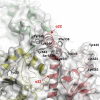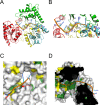Crystal structure of the FeS cluster-containing nucleotide excision repair helicase XPD
- PMID: 18578568
- PMCID: PMC2435149
- DOI: 10.1371/journal.pbio.0060149
Crystal structure of the FeS cluster-containing nucleotide excision repair helicase XPD
Abstract
DNA damage recognition by the nucleotide excision repair pathway requires an initial step identifying helical distortions in the DNA and a proofreading step verifying the presence of a lesion. This proofreading step is accomplished in eukaryotes by the TFIIH complex. The critical damage recognition component of TFIIH is the XPD protein, a DNA helicase that unwinds DNA and identifies the damage. Here, we describe the crystal structure of an archaeal XPD protein with high sequence identity to the human XPD protein that reveals how the structural helicase framework is combined with additional elements for strand separation and DNA scanning. Two RecA-like helicase domains are complemented by a 4Fe4S cluster domain, which has been implicated in damage recognition, and an alpha-helical domain. The first helicase domain together with the helical and 4Fe4S-cluster-containing domains form a central hole with a diameter sufficient in size to allow passage of a single stranded DNA. Based on our results, we suggest a model of how DNA is bound to the XPD protein, and can rationalize several of the mutations in the human XPD gene that lead to one of three severe diseases, xeroderma pigmentosum, Cockayne syndrome, and trichothiodystrophy.
Conflict of interest statement
Figures







References
-
- Friedberg EC, Walker GC, Siede W, Wood RD, Schultz RA, et al. DNA repair and mutagenesis. Washington (D.C.): ASM Press; 2006. 1118
-
- Goosen N, Moolenaar GF. Role of ATP hydrolysis by UvrA and UvrB during nucleotide excision repair. Res Microbiol. 2001;152:401–409. - PubMed
-
- Sancar A. DNA excision repair. Annu Rev Biochem. 1996;65:43–81. - PubMed
-
- Gillet LC, Scharer OD. Molecular mechanisms of mammalian global genome nucleotide excision repair. Chem Rev. 2006;106:253–276. - PubMed
Publication types
MeSH terms
Substances
Associated data
- Actions
- Actions
- Actions
- Actions
Grants and funding
LinkOut - more resources
Full Text Sources
Other Literature Sources
Research Materials
Miscellaneous

